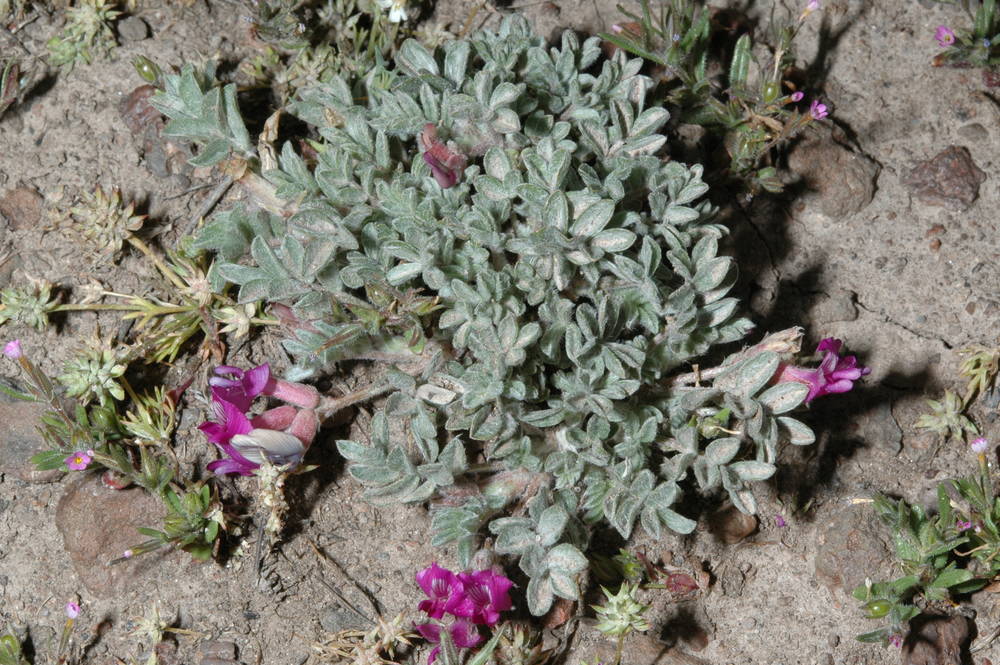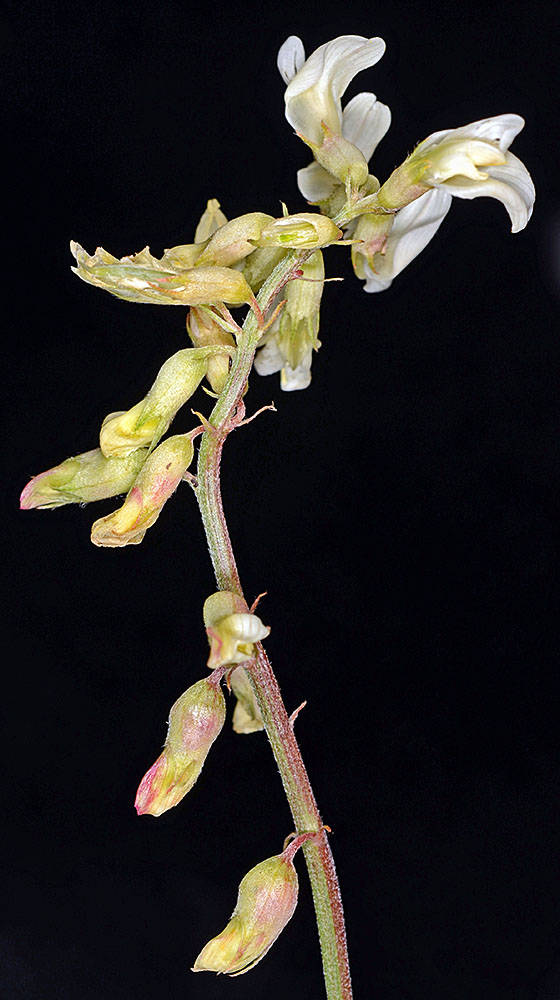Astragalus purshii
Astragalus arthuri
Pursh's milkvetch, woollypod milkvetch
Arthur's milkvetch, Waha milkvetch
prostrate, loosely to densely tufted, 0–20 cm.
several, ascending to erect, forming bushy clumps, 2–40 cm.
1–12(17) cm;
leaflets (3)5–17(21), elliptic to oblanceolate, 2–14(20) × 1–7 mm;
tips obtuse to acute;
surfaces densely villous;
stipules 2.5–15 mm; free.
4–14 cm;
leaflets (15)19–27, linear-elliptic; oval or oblanceolate, 2–20 × 2–4 mm;
tips obtuse to subacute, truncate-mucronulate or shallowly retuse;
surfaces abaxially strigillose, adaxially glabrous;
stipules 2–7 mm; free.
racemes or subumbels, 1–12-flowered;
peduncles 1–14 cm;
bracts 4–9 mm;
pedicels 2–4.3 mm;
bracteoles 0–2.
racemes loosely (5)8–20-flowered;
peduncles (7)10–20 cm;
bracts 1.5–3.5 mm;
pedicels 1–4 mm;
bracteoles usually 0.
ascending at anthesis;
calyces 5.5–16(19) mm, often purple, villous-pilose with white or mixed white and black hairs;
tubes 8.5–12.5 mm;
teeth subulate, 2.2–6 mm;
corollas 19–27 mm; whitish to ochroleucous or pink-purple;
ovules 14–40(46).
declined at anthesis;
calyces 6.6–8.8 mm, strigose with mixed black and white hairs;
tubes 4.5–6 mm;
teeth lance-subulate 1.8–3.5 mm;
corollas 11.7–15.2 mm, ochroleucous;
ovules 16–30.
unilocular, ascending, obliquely ovoid, usually curved, obcompressed, scarcely to deeply sulcate; (7)13–27(30) × 3.5–11 mm, densely white to tawny tomentose or densely villous;
hairs nearly always concealing valve surfaces;
valves coriaceous, sessile or on gynophores 0–1.6 mm.
bilocular, pendulous, linear-ellipsoid, compressed-triquetrous, tapering distally into a slender acuminate beak, nearly straight or gently incurved, deeply sulcate; (25)30–40 × 2.5–4 mm, strigillose;
valves papery;
stipes 6–15 mm.
=24.
Astragalus purshii
Astragalus arthuri
Western North America. ~8 varieties; 4 varieties treated in Flora.
Throughout western North America, particularly in the Intermountain Region, this is a low, tufted milkvetch with white or gray villous hairs and pods resembling balls of cotton. Barneby (1964) stated, “Attempts to devise a practical key to the varieties of A. purshii are never wholly successful.” Variety ophiogenes, the Snake River milkvetch, a native of Idaho, has been reported from Malheur County, but this is apparently based on misidentifications of A. purshii var. lagopinus. Variety ophiogenes has 3–11-flowered racemes and 9–17 leaflets.
Open coniferous forests, grassland slopes, meadows. Flowering May–Jul. 400–1400 m. BW. ID, WA. Native.
Early flowering plants appear subacaulescent as the leaves are in loose basal tufts, and the peduncles appear subscapose. Later in the season, the plants are more obviously caulescent, but even then the peduncles and racemes are longer than the stems. This feature plus the long slender linear pods help distinguish this species.
Richard Halse
Richard Halse
- Local floras:
BC,
CA,
OR,
WA
- Local Web sites:
CalFlora,
CalPhotos,
Flora NW,
PNW Herbaria,
Turner Photog.
WildflowerSearch
iNaturalist (observations)
USDA Plants Database
- LBJ Wildflower Center
- SEINet
- Plants of the World Online
- Encyclopedia of Life
- Wikipedia
- Google Image Search
- Local floras:
OR,
WA
- Local Web sites:
Flora NW,
PNW Herbaria
WildflowerSearch
iNaturalist (observations)
- LBJ Wildflower Center
- SEINet
- Plants of the World Online
- Encyclopedia of Life
- Wikipedia
- Google Image Search





